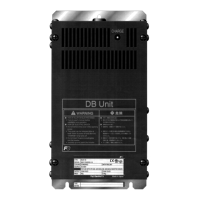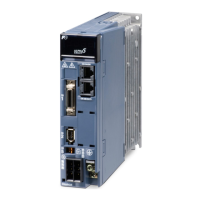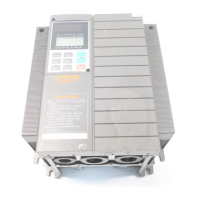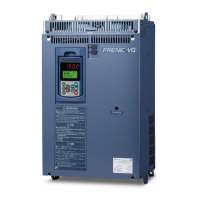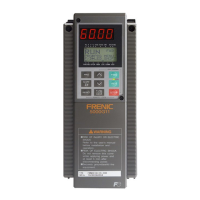7-5
(2) Early warning of lifetime alarm
For the components listed in Table 7.3, you can get an early warning of lifetime alarm at one of the transistor
output terminals ([Y1] to [Y3]) and the relay contact terminals ([Y5A] - [Y5C], and [30A/B/C]) as soon as any of the
conditions listed under the "Judgment level" column has been exceeded.
The early warning signal is also turned ON when a lock condition on the internal air circulation DC fan (on 208V
inverters with a capacity of 50HP or above; on 460V inverters with a capacity of 75HP or above) has been
detected.
Table 7.3 Criteria for Issuing a Lifetime Alarm
Parts to be replaced Judgment level
DC link bus capacitor 85% or lower of the capacitance than that of the factory setting
Electrolytic capacitor on the printed circuit board 87000 hours or longer as accumulated run time
Cooling fan Accumulated run time ≥ 61000 hours
(5HP for 208V and 7HP for 460V or below)
Accumulated run time ≥ 40000 hours
(7.5HP for 208V and 10HP for 460V)
Accumulated run time ≥ 25000 hours
(40HP for 208V, 50HP for 460V or above)
(estimated service life at the inverter’s ambient temperature of
40°C(104°F) under 80% of full load)
7.4 Measurement of Electrical Amounts in Main Circuit
Because the voltage and current of the power supply (input, primary circuit) of the main circuit of the inverter and
those of the motor (output, secondary circuit) include harmonic components, the readings may vary with the type
of the meter. Use meters indicated in Table 7.4 when measuring with meters for commercial frequencies.
The power factor cannot be measured by a commercially available power-factor meter that measures the phase
difference between the voltage and current. To obtain the power factor, measure the power, voltage and current on
each of the input and output sides and calculate in the following formula.
Three-phase input
%100×
(A)t(V)×Curren×Voltage3
(W)powerElectric
=factorPower
Table 7.4 Meters for Measurement of Main Circuit
Item
Input (primary) side Output (secondary) side
DC link bus
voltage
(P (+)-N (-))
Waveform
Voltage
Current Voltage Current
Name of
meter
Ammeter
A
R, AS, AT
Voltmeter
VR, VS, VT
Wattmeter
WR, WT
Ammeter
AU, AV, AW
Voltmeter
V
U, VV, VW
Wattmeter
W
U, WW
DC voltmeter
V
Type of
meter
Moving iron
type
Rectifier or
moving iron
type
Digital AC
power meter
Digital AC
power meter
Digital AC
power meter
Digital AC
power meter
Moving coil type
Symbol of
meter
⎯ ⎯ ⎯ ⎯
It is not recommended that meters other than a digital AC power meter be used for measuring the output
voltage or output current since they may cause larger measurement errors or, in the worst case, they
may be damaged.

